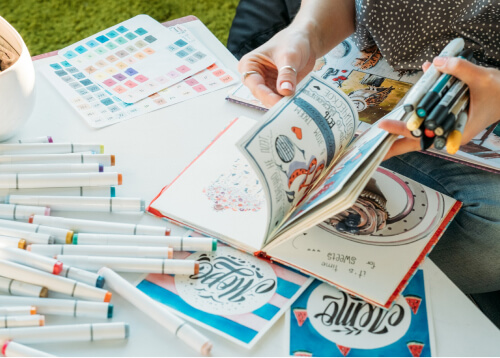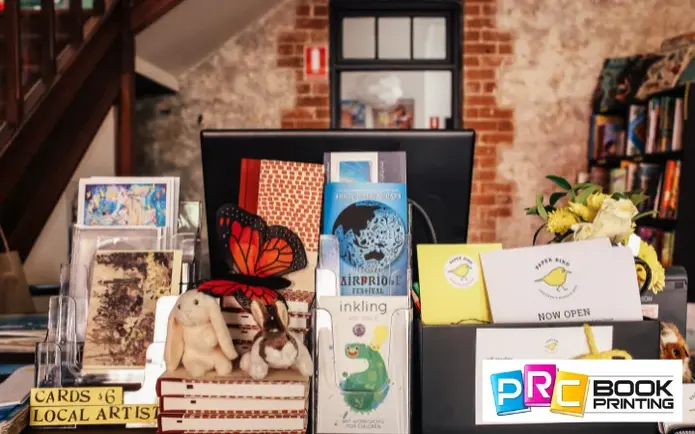Comprehending the Refine Behind Top Quality Art Book Printing for Art Fanatics
When it involves premium art book printing, understanding the details of the process can boost your gratitude for the final item. You might not recognize how crucial paper choice and ink selections are to the vibrancy of artwork. Each component plays a considerable function in attaining the desired result. As you explore the different components of art book printing, you'll discover understandings that could change your perspective on art conservation and discussion.
The Importance of Paper Option in Art Book Printing
When it pertains to art book printing, the selection of paper can make or damage the final product. You want your art work to beam, and the right paper improves shade vibrancy and detail. Think about variables like weight, texture, and finish; these aspects significantly influence just how readers view your work.
As an example, a heavier supply conveys quality and toughness, while a distinctive coating can include deepness to photos. Smooth paper is excellent for in-depth reproductions, allowing fine lines and subtle shades to show up crisp.
Don't ignore the paper's illumination; a brighter sheet can aid shades pop, making your art extra appealing. You'll likewise want to think of exactly how the paper communicates with inks and whether it can handle the printing process without deforming or bleed-through. Eventually, choosing the best paper sets the stage for your art, guaranteeing it records the target market's interest just as you imagined.
Selecting the Right Inks for Dynamic Reproductions
Choosing the appropriate inks is equally as crucial as choosing quality paper to achieve vibrant recreations in your art book. When you're publishing artwork, you desire shades that pop and accurately stand for the initial piece. Select inks with a high pigment concentration; these often tend to create richer and much more saturated shades.
You may consider making use of archival inks, which resist fading over time, guaranteeing your art book remains as striking as the day it was published. If you're working with photos or digitally produced art, pigment-based inks can provide a broader color range, improving information and depth.
Do not forget the finish! Matte and shiny inks can drastically modify the appearance of your art work, so believe about the look you're intending to achieve - art book. Eventually, the appropriate ink choice matches your paper option, creating a stunning aesthetic experience for your viewers
The Function of Shade Management in Print Quality
Shade monitoring plays an important duty in achieving high print high quality for your art book. It assures that the colors you see on your screen equate properly to the published page. Without effective color administration, your vibrant artworks might show up plain or distorted, undermining your innovative vision.
Next off, make use of shade accounts customized for your printer and paper kind. These accounts guide the printer in replicating colors precisely, minimizing disparities in between electronic and printed versions.
When you prepare your files, think about utilizing a color space like Adobe RGB or CMYK, depending upon your printer's specs. Always proof your work, also; an examination print can disclose any type of prospective color issues before the final run. By focusing on shade administration, you secure the stability of your art, guaranteeing your target market experiences it as you planned.

Understanding Various Binding Techniques
Attaining the best try to find your art book goes past color monitoring; binding methods also play a significant function in its overall discussion and durability. You have numerous alternatives to review, each with its own unique attributes.
If you're aiming for a specialist feel, situation binding offers a strong option with a hard cover, perfect for showcasing your art work. On the other hand, excellent binding offers an adaptable spine while maintaining expenses down, making it a prominent selection for softcover books.
Spiral binding enables your art book to lay level, which is terrific for presenting images without obstruction. Saddle stitching is optimal for smaller sized pamphlets, giving a clean coating without the bulk.
Eventually, the binding method you pick should show your creative vision and just how you desire readers to engage with your work. Make certain to weigh these options very carefully to attain the very best outcome for your project.
The Impact of Print Size and Design on Discussion
While the choice of print dimension and design might appear second to web content, they greatly influence how your artwork is perceived. The dimensions of your prints can either enhance or reduce the effect of your pieces. Larger prints can this post draw audiences in, enabling them to appreciate elaborate details, while smaller formats could require even more intimate involvement.

Preservation Strategies for Resilient Art Books
To assure your art publications stand the test of time, it's essential to apply efficient preservation methods. Usage acid-free storage boxes or safety sleeves to shield them from dirt and physical damages.
When handling your publications, constantly wash your hands or put on cotton handwear covers to avoid oils and dirt moving onto the web pages. Prevent flexing or wrinkling the spines; rather, make use of book supports when showing them.
For included security, take into consideration investing in archival-quality materials for any kind of repairs or enhancements. Regularly check your collection for indications of wear or damages, addressing problems without delay. By complying with these basic strategies, you can guarantee your art books stay vivid and accessible for years to find, protecting their elegance and worth for future generations.
Working together With Printers for Optimum Outcomes
When you're ready to print your art book, choosing the best printer is necessary to accomplishing your vision. Clear interaction concerning your assumptions and requirements will certainly help assure that both you and the printer get on the same page. Let's explore how to make this collaboration as seamless and effective as possible.
Selecting the Right Printer

Effective Interaction Approaches
Effective communication is essential for turning your art book vision into fact, especially when collaborating with printers. art book. Begin by plainly describing your job's objectives, consisting of design components, favored products, and any particular printing methods. Do not hesitate to share your motivations and recommendations; this aids the printer recognize your aesthetic
Set up normal check-ins to talk about progression and address any concerns. Use visuals, like mock-ups or samples, to communicate your concepts extra effectively. Be open to feedback, as printers frequently have useful understandings that can improve your job. Lastly, preserve a positive relationship by being respectful and appreciative of their competence. This collaboration will assure that your art book fulfills your assumptions and beams in its last type.
Regularly Asked Inquiries
What Prevail Errors to Avoid in Art Book Printing?
When publishing your art book, prevent common blunders like inadequate resolution pictures, incorrect shade accounts, and ignoring page format. Do not forget to check and verify details to validate your end product fulfills your expectations.
How Does Digital Printing Differ From Typical Printing Techniques?
Digital printing uses electronic data to develop prints directly, enabling quicker turn-around and customization. In comparison, read what he said standard methods include physical plates, which can be time-consuming and much less flexible for small runs or one-of-a-kind designs.
What Is the Regular Turnaround Time for Art Book Printing?
The regular turnaround time for art book printing differs, but you can anticipate it to take anywhere from a couple of weeks to a number of months. Variables like complexity, advice amount, and printing method all affect this timeline.
Can I Print a Restricted Version Art Book Economically?
You can publish a limited edition art book financially by selecting economical products, enhancing print runs, and using electronic printing choices. Mindful planning and budgeting will aid you achieve high quality without spending beyond your means.
What Are the Environmental Considerations in Art Book Printing?
When taking into consideration art book printing, you should believe concerning environmentally friendly materials, lasting inks, and energy-efficient procedures (art book). Choosing regional printers can additionally reduce your carbon footprint, making your job both lovely and eco responsible